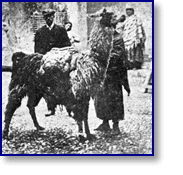 Destination Kansas City:
Destination Kansas City:
This isn't Antifreeze!
< Back | Main menu | Next >
Father Nieuwland's neoprene shows the world that synthetic rubber can be successful, and does not have to be chemically identical to natural rubber to have good properties. In fact, a different structure could give the rubber better properties than the natural product. The following story is about another serendipitous discovery of a material with superior properties.
In 1922, Dr. Joseph C. Patrick is in his lab in Kansas City trying to make an automobile antifreeze. When he mixes ethylene dichloride and sodium polysulfate, he is surprised to find that instead of antifreeze he has made a milky suspension. When the mix is allowed to coagulate and dry, the product bounces and stretches like raw natural rubber. If this product is heated, it will crosslink without the addition of sulfur needed to vulcanize natural rubber.
Well, it's not what he's looking for, but Dr. Patrick get dollar signs in his eyes. He knows he has made a marketable synthetic rubber. The raw materials are easy to make, it takes no effort to make the rubber, and it can be made in many different grades. He also finds that, unlike natural rubber, his new rubber has oil resistance. He calls his creation Thiokol.
Thiokol is put into commercial production by the Thiokol Corporation of Yardville, NJ in 1930 and is sold as a specialty rubber for about $0.30 per pound, or about 2 or 3 times the price of natural rubber at the time. Thiokol's only problems are it's strong sulfur odor, lower elasticity than natural rubber. It also releases fumes that made one's eyes tear, like when you cut an onion, when it is being processed. People are willing to suffer a little, however, and pay the extra cost due to Thiokol's great oil and solvent resistance.
-
Next stop: Jersey - Sharing with Standard
Meanwhile...
While Dr. Patrick is making serendipitous discoveries in his lab in 1922, the world outside his lab is busy, busy, busy!
The highest temperature ever recorded in the world, 136°F (58°C) in the shade, is reached in Al Aziziyah, Libya on September 13. (If it was so hot, I wonder why Dr. Patrick was trying to make antifreeze?)1922 was a year of great political change. The Irish Civil War begins. The Union of Soviet Socialist Republics (USSR) is formed. The Ottoman Empire Falls. Great Britain grants Egypt it's independence. Benito Mussolini begins his fascist reign of Italy. (Maybe it's the heat.)
Howard Carter discovers the treasure filled tomb of the ancient Egyptian King Tutankhamen. (Independence and the treasure of an ancient ruler, it's a big year for Egypt!)
References
-
1. Herbert, Vernon and Attilio Bisio. Synthetic Rubber: A Project That Had to Succeed. Westport, Connecticut: Greenwood Press, 1985.
2. Howard, Frank A. Buna Rubber: The Birth of an Industry, D. van Nostrand Company, Inc., 1947.
3. Wolf, Howard and Ralph. Rubber: A Story of Glory and Greed. New York: Covici, Friede, 1936.
